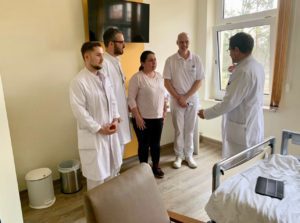Welcome to the Rare Classroom, a new series from Patient Worthy. Rare Classroom is designed for the curious reader who wants to get informed on some of the rarest, most mysterious diseases and conditions. There are thousands of rare diseases out there, but only a very small number of them have viable treatments and regularly make the news. This series is an opportunity to learn the basics about some of the diseases that almost no one hears much about or that we otherwise haven’t been able to report on very often.
Eyes front and ears open. Class is now in session.

The rare disease that we will be learning about today is:
Adult-Onset Still’s Disease
What is Adult-Onset Still’s Disease?
- This is the form of Still’s disease that originates during adulthood
- Still’s disease is rare, autoinflammatory systemic disease with a definitive triad of symptoms
- These include a salmon colored rash, fever, and joint pains
- It presents similarly to several other autoimmune or inflammatory diseases, meaning that other conditions need to be excluded
- The disease is very similar to juvenile rheumatoid arthritis (also called juvenile-onset Still’s disease)
- Still’s disease is named after Sir George Frederic Still, an English physician. Adult-onset Still’s disease was first described by E.G. Bywaters in 1971.
- One study divided 21 patients into four different categories:
- Monocyclic systemic disease
- Polycyclic systemic disease
- Chronic articular monocyclic systemic disease
- Chronic articular polycyclic systemic disease
How Do You Get It?
- Unfortunately, the cause of adult-onset Still’s disease remains almost completely unknown.
- Research suggests a link to interleukin-1 (IL-1) since medicines that block IL-1β are an effective treatment
- Patients express high levels of interleukin-18
- The incidence rate of adult-onset Still’s disease 1.6 per 1,000,000
- Age of onset is concentrated in two ranges: 16-25 and 36-46 years old
What Are The Symptoms?
- Symptoms are important for diagnosing adult-onset Still’s disease
- Major signs and symptoms that can serve as diagnostic criteria include:
- Fever of at least 39°C for at least a week
- Leukocytosis with a predominance of granulocytes
- Arthralgia or arthritis for two weeks or more
- Salmon-colored rash that does not itch, usually over the extremities or torso
- Other signs/symptoms can include:
- Enlarged liver and/or spleen
- Sore throat
- Abnormal liver function tests
- Lymphadenopathy
- Elevated serum ferritin
- Severe fatigue
- More serious complications include:
- Fluid accumulation in the heart and lungs
- Hearing loss
- Aseptic meningitis
- Fulminant hepatitis
- Hemophagocytic lymphohistiocytosis
How Is It Treated?
- Anti-inflammatory medicines are critical for treating adult-onset Still’s disease. These include:
- Steroids such as prednisone
- Chemotherapy agents such as anakinra, methotrexate, and cyclophosphamide and
- Monoclonal antibodies, such as rituximab.
- Some newer therapies have been introduced that target IL-1.
- Canakinumab, an anti-IL-1 therapy, was approved by the FDA for adult-onset Still’s disease in June 2020, making it the first therapy officially approved for treatment of the disease.
Where Can I Learn More???
- Learn more about this disease from the National Organization for Rare Disorders.
- Check out our cornerstone on this disease here.






